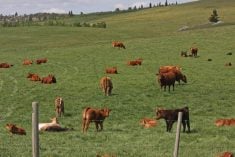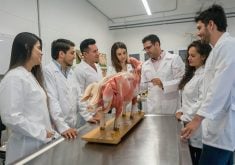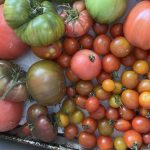When I started writing this article, I planned to write about marriage, families and relationships, since Don and I celebrated our 25th anniversary on July 7.
As well, at the end of the month, we’re planning an Anderson reunion (my mother’s family) where we’ll be celebrating my parents’ 50th anniversary and also my aunt and uncle’s 50th. However, as I sat at my computer, my mind kept focusing on the Agricultural Biotechnology International Conference ’98. About 650 people from 26 countries attended this June conference in Saskatoon.
The conference was about agricultural biotechnology and exploring strategies for ag-biotech product development and marketing. People spoke about the biotechnological revolution.
Read Also

Fuel rebate rule change will affect taxes and AgriStability
The federal government recently announced updates to the fuel rebates that farmers have been receiving since 2019-20.
Revolutionary change is always difficult because we like to feel in control of our future. There is uncertainty about biotechnology, but in general, Canadians seem accepting of it.
It is thought that biotechnology can enable the world to meet the growing demand for food as the population continues to rise.
Biotechnology involves using biological processes to produce substances beneficial to agriculture, the environment, industry and medicine.
Biotech beginnings old
This is not new. For years, manufacturers of antibiotics, cheese and wine have relied on the activity of various fungi or bacteria. Biotechnology uses living organisms (or parts of them) to create new products. Scientists can use genetic engineering to change consumer products and to increase the nutritional quality of food and feed grains.
There are many examples of products developed through biotechnology:
- Tomatoes that can ripen on the vine and then maintain their flavor and texture for several weeks.
- Potato plants resistant to the Colorado potato beetle.
- Animal vaccines from micro-organisms and microbial products.
As well, many other avenues are being explored by scientists:
- More convenient foods with fast-rising dough and new processes to clarify fruit juices and wine.
- Nutritionally enhanced foods, such as a genetically engineered potato that absorbs less oil when cooked, animals with leaner meat, cereal with more nutrients.
- Cheaper and more environmentally compatible fertilizers and pesticides.
In addition to increased population, changes in the level of affluence in developing nations are expected to affect the demand for food. The United Nations’ Food and Agricultural Organization predicts that the next revolution will boost yields without using excessive amounts of chemical fertilizers or pesticides. One of the key components will be agricultural biotechnology.
Different speakers at the conference highlighted different aspects of biotechnology. One of my favorite speakers was John Oliver, Maple Leaf Bio-concepts, Canada. Oliver said four events affecting the world today are:
- As Asia becomes industrialized, the demand for animal product increases. The Asian diet is changing from starches to animal protein and vegetable oils. There is difficulty in producing feed grains for agriculture to address the needs for animal protein in the diet. We need better conversion, and efficient feed stocks.
- Aging baby boomers are health conscious. Eighty million North Americans are over 46 years of age. They are predicted to live longer than any previous generation. There is a major change in lifestyle, information, health, nutrition and medicine. The healthy diet is seen as a form of health insurance. Baby boomers will buy products at a premium price if they are healthy. Two products that will be on the market are in the designer food class. They are quality of life products for greater health and increased energy, and pharmafood products with specific claims for cancer prevention, cholesterol lowering and other wellness claims.
- Biotechnology will be used to enhance feed stock reserves and plant protein to meet industrial demand for oils.
- Urban populations are concerned with environmental issues, such as air and water pollution, resulting from the increased animal protein production.
Oliver compared food production changes in the world to the Titanic. Agricultural biotechnology will lessen the impact of hitting the iceberg, he predicted.
Another speaker, Karen Lapsley, a food scientist with Ceapro Inc. of Edmonton, spoke about global trends that drive the food industry. She spoke about functional foods as compared to conventional foods.
A functional food is similar in appearance to a conventional food, is part of our usual diet, and also provides benefits against chronic health problems.
A nutraceutical is any substance that is a food or part of a food and provides medical or health benefits, including the prevention and treatment of disease.
In Canada, the Food and Drug Act determines the regulations and guidelines for the food industry.
J.R. Hillman, of the Scottish Crop Research Institute, stated: “The potential of technology will not be realized without consumer acceptance. The benefits must directly meet the consumer and environmental needs. Consumers need choices, and therefore labeling. There needs to be informed, open and balanced discussion.”
Negative perceptions of biotechnology in the agricultural sector in Europe and other countries are damaging the wider biotechnology industry and the corporate reputations of its leading players. Forces of global competition are coming into conflict with local values, political systems and popular beliefs. There is a perception that the agricultural industry is only interested in profit, even at the risk of imposing damage or risk to human health.
The task is to better manage this process so agricultural biotechnology is not at risk due to these perceptions.
There seems to be a low understanding of science and agriculture among consumers, politicians and the mass media. Because communication is almost instantaneous around the world, it is necessary to have accurate information, education, and communication in the area of biotechnology.
Javier Verastegui of Cambiotech Canada in Ottawa is working with managing international relationships in Latin America. Canadian bioproducts presently in the marketplace include: 27 drugs, 28 plants, 41 veterinary biologies (eight vaccines and 33 diagnostics), four enzymes (cheese, alcohol), and 26 feed ingredients.
The Canadian industry uses a multisectoral approach, working with product developers, users and the service industry.
Boom times
There are 530 small and medium-sized companies employing 23,000 people, with $3.5 billion in revenues, and $1.7 billion invested in research and development.
The companies discover new uses of plants for nutraceuticals and functional foods, such as canola, corn, flax and potato.
According to Karen Marshall, who works for Monsanto, biotechnology in North America is a basic part of agriculture now. Fifty percent of the canola grown in Canada, and 40 percent of cotton, 30 percent soybean in the United States are biotechnologically developed.
A growing world population puts immense pressure on food production capabilities. Scientists and researchers are making contributions to solving the world’s food and environmental problems.
To deal with consumer concerns about the safety of these new technologies, scientists and government regulators have taken steps to assess all new products of biotechnology.
Before a product can be released into the environment or made commercially available, it may be evaluated for safety and effectiveness based on data collected from extensive testing.
The Canadian Food Inspection Agency, along with other federal departments, regulates products of biotechnology in order to protect human health, animal health, and the environment.
CFIA is the lead agency responsible for regulation of all agricultural products. Health Canada assesses food safety, and Environment Canada regulates products not covered by other legislation.















